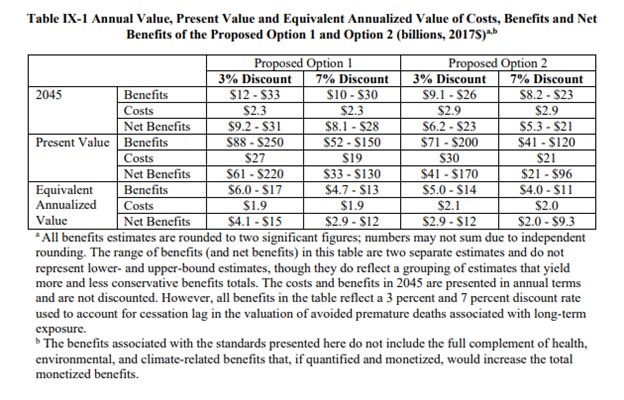On August 5, 2021, the Environmental Protection Agency (EPA) announced plans to reduce greenhouse gas and air emissions from heavy-duty trucks through a series of rulemakings over the next three years. The first rulemaking, to be finalized this year, applies to heavy-duty vehicles starting in model year 2027. The rulemaking sets new standards for criteria pollutants (including nitrous oxides, particulate matter, and carbon monoxide) for the entire sector as well as targeted updates to the current greenhouse gas emissions standards. A second rule is expected to set more stringent greenhouse gas emission standards for new heavy-duty vehicles sold in model year 2030 and beyond.
On March 7, 2022, EPA released the first piece of the proposed rule, which is the most costly rulemaking thus far in 2022, with cost estimates pushing $30 billion. While EPA estimates that the economic benefits of the rule exceed the costs, truckers and manufacturers warn that the rule is too stringent and costly, and that compliance could send higher prices through the economy that is already suffering from high energy costs and high inflation.
Background
EPA’s rulemaking was a result of an executive order from President Biden that forces limits on emissions from buses, delivery vans, tractor-trailers and other heavy trucks and attempts to force the transition to all-electric vehicles. It will be the first time in more than 20 years that tailpipe standards have been tightened for this component of transportation, although great reductions in emissions have occurred since low sulfur fuel was required for diesel engines. The draft rule would require heavy-duty trucks to reduce emissions of nitrogen dioxide by 90 percent by 2031.
The new rules for nitrogen oxide emissions would apply to trucks beginning with the model year 2027, while the rules for carbon dioxide, the primary component of greenhouse gases, would apply to trucks starting with the model year 2024. The proposed regulations will require some trucks, 17 of the 33 categories of heavy-duty trucks, to lower their carbon dioxide emissions, which is designed to bolster sales of all-electric trucks in the United States, from fewer than 1,000 in 2020 to about 1.5 percent of total truck sales, or roughly 10,000 trucks, in 2027.
The federal government last updated its truck emissions rule in 2001, when commercial trucks had to cut emissions of nitrogen dioxide by 95 percent over 10 years. National nitrogen dioxide emissions dropped 40 percent according to EPA, who expects the new rule to contribute a 60 percent drop in those emissions by 2045.
Late last year, the EPA tightened standards on auto emissions and announced new rules for limiting methane emissions. This year, the agency is expected to roll out new restrictions on greenhouse gases and on industrial soot released by power plants. The E.P.A. is working on new limits for auto emissions, due out next year, which it hopes will accelerate a transition to electric vehicles. Mr. Biden has pledged that half of all new cars sold in the United States by 2030 will be electric vehicles.
Truckers’ Reaction
Obviously, the new rulemaking will increase costs to truckers if it is even technologically feasible. “This new standard simply may not be technologically feasible,” said Jed Mandel, president of the Truck and Engine Manufacturers Association, an industry group. “We’re worried about the cost. There is a potential of adverse impacts on the economy and jobs. Nobody wants to see union jobs laid off. Regular lunch-pail, blue collar workers.”
Jay Grimes, director of federal affairs for the Owner-Operator Independent Drivers Association, said new restrictions would be especially onerous for small truckers, which he said comprise 90 percent of the industry. “We’ve seen since the start of the pandemic the efforts truckers are making on a daily basis to keep the supply chain stable,” Mr. Grimes said. “Higher prices on the small business side are going to get passed down to consumers in the supply chain.”
EPA Rule Options
Two different options are under consideration for implementation—both begin in covering model year 2027 and later vehicles. “Option 1” sets more stringent emissions levels at the outset and further tightens such standards beginning with model year 2031 vehicles. However, EPA estimates that the more rigorous set of standards from Option 1 would lead to greater emission reductions than Option 2, but also expects the more aggressive option (Option 1) to yield lower costs. (See table below.)

Conclusion
President Biden tried to push ambitious climate legislation through Congress during his first year in office through the Build Back Better bill, only to see it stall, so now his administration is using its regulatory machinery to further his climate program. Edicts are exactly what Biden’s Climate Czar, Gina McCarthy, promised in July 2021. The Clean Truck Plan is the first major push in that direction, costing upwards of $30 billion, depending on the option chosen. Truckers, 90 percent of which are small firms, find the plan overwhelming and rightly see it adding costs to Americans as the trucking industry is responsible for most of the overland freight movement in the United States, with the market being worth $732.3 billion in 2020. Biden is continuing his destruction of American pocketbooks through the cost increases in his regulatory agenda, which will eventually make the American economy suffer.



